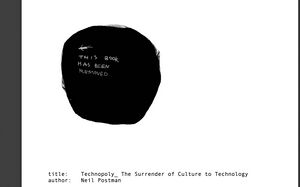Bruise Bibliotecha
Bruise Bibliotecha is a local digital library initiated by Mateus Domingos, currently installed at Two Queens (Leicester).
It uses the digital book-sharing framework Bibliotecha which facilitates local distribution of files in small communities, using open-source software to serve files locally over a wifi hotspot. Using a browser to view files, visitors can donate or retrieve books and recatalogue their collections over time.
The system consists of a small microcomputer (a Raspberry Pi 3), running the open-source ebook management software Calibre. Other configurations allow the computer to create a web server over a local area network wifi hotspot, meaning that files are only shared within physical proximity to the server.
The library is maintained within a shared space, where items in the catalogue need to be organised with consensus. Part of this conversation is the recording of books that have been removed from the library.
Mateus describes the contingency:
"The group I'm working with wanted some kind of process/protections in place to avoid members distributing copyrighted material. I'm not super comfortable with this, but can understand why they think it's necessary. So, I'm thinking more about the potential for the acts of librarianship and other things that happen-the tasks of the contingent librarian.
I realised I needed to create a how-to document for users of the library and the other folks who might take on admin roles. At least some of these people would need to know how to remove content if it didn't conform to the agreed rules of the space. I uploaded a couple of texts to test out the removal process. I'm not sure why, but on this first attempt the delete book option was not showing up (it appears to be there now).
As a workaround I uploaded an alternate format document (which just reads, this book has been removed). Having done this, I was then able to delete the actual version of the text. Inspired by Pedro Sá Couto I then thought about creating a modified version of the cover, which marked it as being removed.
I have this working using a simple imagemagick command that stamps an image on the original cover.
This feels like a nice way of indicating texts that have been in the library and possibly makes it easier for folks to share reading lists, through the bookshelf feature or similar methods. It keeps the book as an object that metadata can be added to, and so can remain part of the dialogue of the library."

